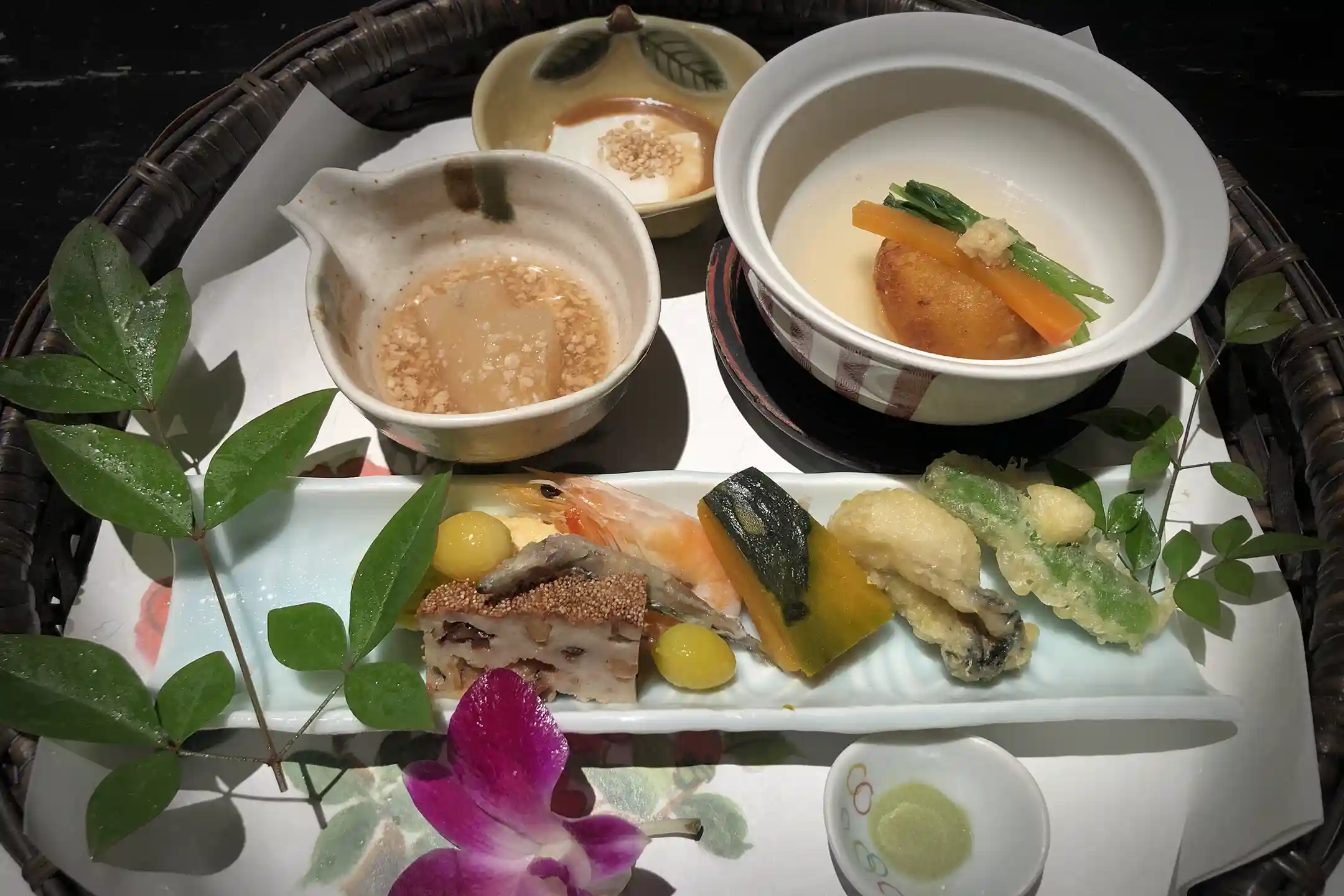Tokyo’s Japanese restaurants blend techniques honed over centuries with fresh influences learned from abroad, serving up extraordinary dining experiences you won’t find anywhere else. Classic Edo‑era staples such as sushi and tempura gain contemporary twists that captivate diners from all corners of the globe.
For many Western visitors, the meticulous attention to detail, reverence for the seasons, and theatrical sense of omotenashi—hospitality that encompasses the entire space—can spark a fascination with Japan’s “mysterious, multifaceted culture.” In this article, you’ll discover perspectives that deepen that curiosity and guide you through the many‑sided allure of washoku culture available only in Tokyo.
Characteristics of Japanese Restaurants in Tokyo
Historical Background of Japanese Cuisine
To truly understand today’s Tokyo dining scene, you need to trace its roots. Modern Tokyo blossomed after the shogunate established Edo as its capital in the 17th century. Back then, commoners enjoyed sushi and tempura at casual street stalls, and the “Edomae” style was born. These foods were more than sustenance—they were part of a playful contest of iki (refined chic).
At the same time, warrior and merchant cultures from Kyoto and Osaka merged with Edo’s bold cooking style, infusing artistry and gracious hospitality into what we now call washoku. If your first taste of Japanese cuisine leaves you marveling at how delicacy and daring coexist, that paradox stems from this historic fusion.
Post‑war economic growth spurred a boom in dining out, and specialty eateries flourished. As international techniques and ingredients streamed in, more chefs began crafting innovative menus while preserving tradition. Absorbing Western efficiency and presentation yet respecting uniquely Japanese values remains a defining Tokyo trait today.
The Diversity of Tokyo’s Food Culture
Tokyo draws ingredients and chefs from every region, letting you savor a nationwide spectrum of Japanese cuisine in one city. Beyond Edomae staples like sushi and tempura, you’ll encounter kaiseki, kaiseki‑inspired banquet courses, shabu‑shabu, sukuyaki, and more. Artisans refine these dishes in their own ways and weave in Western techniques or products, evolving them into hybrid styles where heritage meets trend.
Table manners—think deft chopstick etiquette—also add novelty for Western diners. Even slight custom differences can highlight values unlike your own. Rather than label them “odd,” learning the historical and regional reasons behind each practice doubles the intrigue. That mutual understanding is a key to deeper enjoyment.

Restaurant Design and Aesthetic Sensibilities
In Tokyo’s Japanese restaurants, spatial beauty matters as much as the meal. Some haute establishments embrace wa‑modern interiors—natural materials reimagined with contemporary flair—to balance calm and sophistication. The guiding belief: let space amplify the cuisine’s subtlety, emphasizing the “vast world inside the small.”
Collaborations with star designers and architects are rising, featuring art displays or lighting that mirrors the seasons. By leaving intentional blank space, the room itself grants diners a moment of quiet relief from city life. From a Western viewpoint, this “designed emptiness” feels distinctive—almost as if you’ve stepped into a living artwork or stage set.

Major Japanese Cuisine Styles and Key Highlights
Sushi (Sushi in Tokyo)
Craftsmanship and Artistry
Edomae sushi epitomizes Tokyo’s culinary theater: a chef unites topping and rice right before your eyes. Seasonal seafood sourced nationwide is brought to its peak state for each piece. While Western fine dining also prizes presentation, sushi distills flavor, aroma, temperature, and appearance into a single bite. Repeating that “small artwork to mouth” moment yields a uniquely refined pleasure.
How to Secure a Spot at Hard‑to‑Book Restaurants
Some Tokyo sushi counters fill reservations months ahead. Michelin‑starred icons are especially competitive. When direct booking proves tough, tap your hotel concierge or premium credit‑card concierge. Japan’s “regulars‑first” culture can feel puzzling, yet understanding it offers insight into how relationships shape society—beyond merely landing a seat.

Kaiseki Cuisine (Kaiseki in Tokyo)
Seasonality and Hospitality
Rooted in the spirit of the tea ceremony, kaiseki symbolizes the seasons through ingredients, tableware, and plating. Western chefs also cook seasonally, but kaiseki magnifies nature‑respect and guest‑care into an art form. Each quietly paced course feels like browsing a miniature gallery of edible installations.
Meticulously Curated Spaces
Many kaiseki proprietors personally direct interior details, from seasonal flowers in the tokonoma alcove to modernized shoji screens. Subdued lighting highlights tableware hues, reflecting a belief that “meaning resides in the unseen.” Unlike Western extravagance, this tranquil staging creates a lingering richness of time.
Tempura, Shabu‑Shabu, and Sukiyaki
Ingredient Quality and the Chef’s Discerning Eye
These single‑focus dishes rely squarely on ingredients. Tempura demands precise oil temperature, while shabu‑shabu and sukiyaki hinge on premium wagyu sliced paper‑thin—an approach unlike Western steak culture. High‑end venues often source vegetables from contract farmers and branded beef from specific ranches. Many now pair Japanese fundamentals with Western herbs or produce, dissolving the line between washoku and yoshoku in Tokyo’s multicultural milieu.

Tips for Choosing a Restaurant
Seeking an Elegant Space and Quiet Ambience
If you crave a serene setting, focus on lighting and private‑room layouts. Roppongi’s “Saryo Miyasaka,” for instance, pairs chic décor with hushed calm—ideal for deep conversation. Western venues often highlight BGM, yet many Japanese restaurants treat silence itself as “music,” letting the sounds of cooking and the room’s atmosphere sing, immersing you in Japan’s culture of ma (thoughtful pauses).
Commitment to Sustainability and Advanced Techniques
Eco‑conscious dining has surged in Japan. Chisan‑chishō (local production for local consumption), food‑waste recycling, and reusable resources link Western green movements with Japan’s historic “mottainai” spirit. Restaurants awarded Green Stars draw attention by preserving traditional ingredients and methods while planning for the future—an attitude that mirrors Japan’s respect for heritage and forward gaze.
Restaurants Offering Cultural Experience Programs
If you long to learn as well as eat, seek venues with cooking classes, sake tastings, or pottery workshops. Making washoku yourself or shaping your own plate immerses you in Japanese lifestyle culture. Beyond novelty, grasping how daily life and beliefs root each dish yields lasting satisfaction.
Recommended Area‑by‑Area Guide
Ginza & Yurakucho Area
Ginza is famed for venerable institutions standing alongside rising stars. “Ginza Kojyu” offers authentic kaiseki in a warm, sukiya‑style space and earns high praise for attentive care toward international guests. Meanwhile, “Ginza Kyubey,” founded in 1935, lets you watch masterful sushi skills from across the counter. Strolling among Ginza’s art galleries and luxury boutiques, you’ll sense a streetscape where Japanese tradition fuses with Western commercial culture.
Tempura newcomer “Tempura Kondo Ginza Onodera” adds original touches to classic Edomae tempura, earning popularity among global gourmets. This coexistence of heritage and innovation proves Japan’s culinary scene values not just safeguarding the old but continually creating new worth.

Omotesando & Aoyama Area
Trendsetting Omotesando–Aoyama teems with distinctive washoku. At “Den,” playful courses and warm hospitality have won worldwide acclaim, including Michelin stars and a Green Star. True to those honors, the team champions “coexistence with the community” and sustainable cooking while showcasing creativity.
“Ise Sueyoshi” provides vegan and halal options, embracing guests with varied faiths and diets—an adaptive spirit befitting cosmopolitan Tokyo. Restaurants like “NARISAWA,” which centers on harmony with nature, make this district a crossroads of global sensibility and Japanese refinement.
Asakusa & Ueno Area
Rich in Edo‑period and Meiji‑era ambience, Asakusa–Ueno hosts many long‑standing favorites. “Komagata Dozeu Asakusa Main Store,” over 200 years old, still serves dojo loach hotpot—perhaps “unusual” at first glance, yet steeped in the depth of commoner culture. “Asakusa Imahan Main Store,” famed for sukiyaki since the Meiji era, pairs nostalgic architecture with top‑grade wagyu for a special meal.
Ueno’s “Innsyoutei” offers serene kaiseki amid gardens—perfect for a touch of luxury during downtown sightseeing. Savoring Japanese cuisine while feeling Edo’s atmosphere lets you tap into Japan’s enduring spirit.
.webp?width=750&height=500&name=A%20stall%20selling%20grilled%20Japanese%20rice%20dumplings%20(dango).webp)
Marunouchi & Nihonbashi Area
Business‑focused Marunouchi and history‑laden Nihonbashi converge urban polish with downtown culture. “SUIGIAN” houses an authentic Noh stage, delivering a uniquely Japanese dinner‑and‑performance experience where audience and art interweave rather than sit apart as in Western dinner shows.
“Nihonbashi Yukari,” founded in 1935, features a third‑generation chef who modernizes kaiseki with locally grown Edo‑Tokyo vegetables, balancing time‑honored technique and current tastes—apt for its business‑heavy setting. At “Wadakura,” you can savor refined kaiseki while gazing over the Imperial Palace Outer Gardens, a convenient choice for overseas professionals. Tokyo Station’s blend of global access and historical charm brings fresh surprise to Western guests.
Conclusion――Experiencing the Deep Fusion of Culture and Gastronomy at Japanese Restaurants in Tokyo
Tokyo’s Japanese restaurants honor time‑tested traditions while eagerly embracing new ingredients and techniques. Sushi, tempura, kaiseki, sukiyaki—each dish carries its own history and aesthetics, making none quite like another. For Western visitors, the meticulous details, spatial staging, and artisanal skills feel refreshingly novel.
Japan’s mindset of “packing profound meaning into small spaces” and “eliminating waste while coexisting with nature” also garners global attention for environmental stewardship. By joining food‑culture programs linked with local communities and crafts, you can sense the landscapes and histories that nurture each ingredient—drawing closer to washoku’s essence.
From venerable Ginza counters to inventive Omotesando kitchens, from nostalgic Asakusa to sophisticated Marunouchi, every Tokyo neighborhood reveals a different facet of delight. As you dine, look beyond the visual splendor to the stories and traditions beneath, and each bite will become all the more special.
Author Bio




.webp)
.webp)
